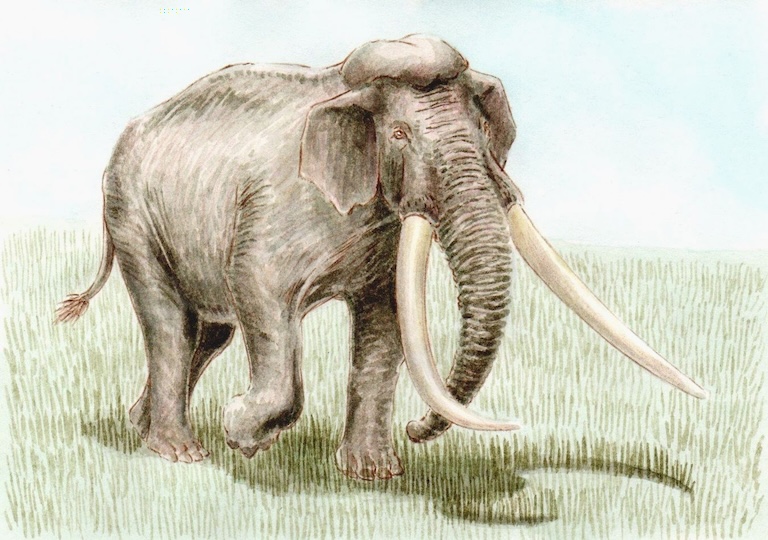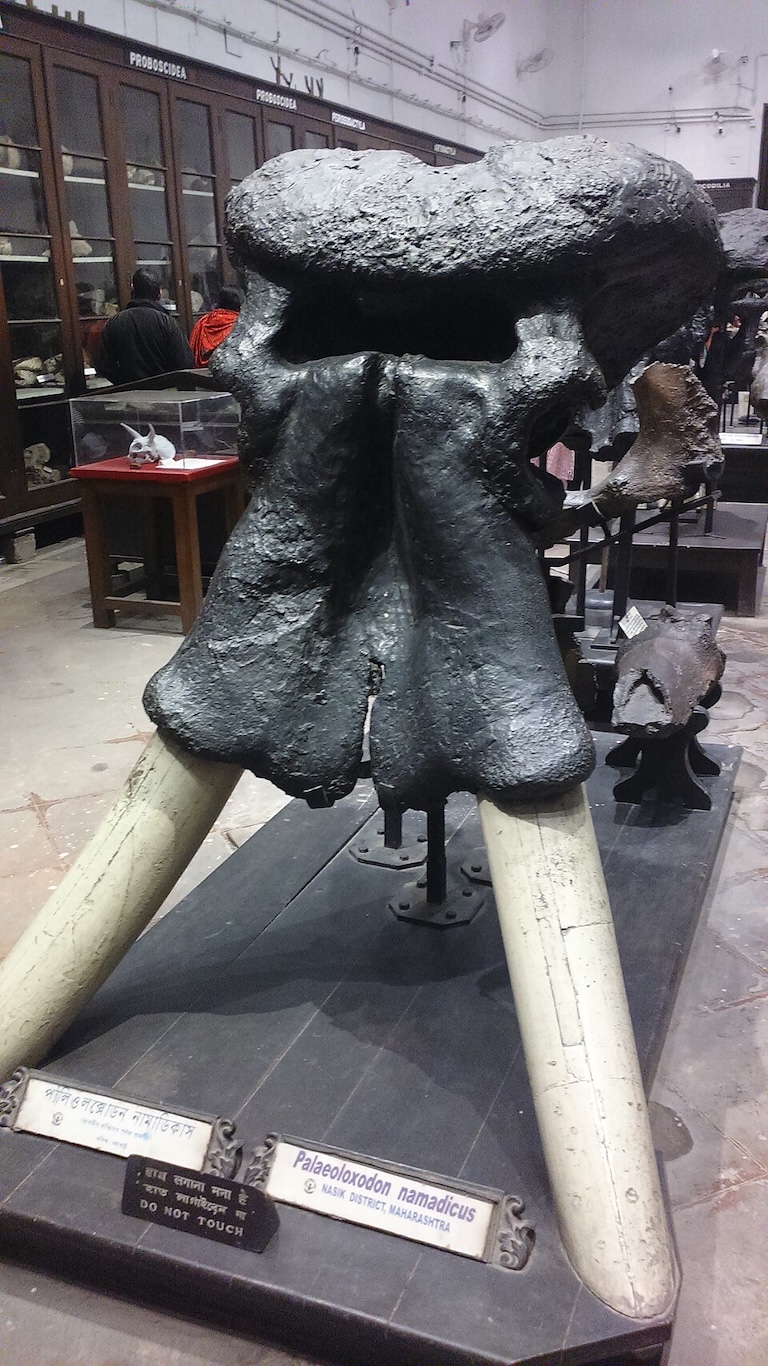Indian Straight-Tusked Elephant Profile
If you go back to before the Himalayas were formed, there was a family of 20-ton, long-necked rhino-like creatures roaming about the place. These giant mammals may hold the record for the largest land mammal to have ever existed.
But unlike the Paraceratherids, the number one contender for this title didn’t go extinct tens of millions of years ago. This giant shared its habitat with modern humans in Asia. That means our ancestors likely looked one of these Behemoths in the eye.
And then probably ate it.

Indian Straight-Tusked Elephant Facts Overview
| Habitat: | Plains |
| Location: | India, China, and Southeast Asia |
| Lifespan: | Unknown |
| Size: | At least 4.5m (14.8ft) tall |
| Weight: | Likely 14 tons or more |
| Colour: | Unknown |
| Diet: | Grasses |
| Predators: | Large carnivores, humans |
| Top Speed: | Unknown |
| No. of Species: | 1 |
| Conservation Status: | Extinct |
This straight-tusked elephant was one of perhaps six species of highly successful giants, originating in Africa and migrating over the world, eventually reaching India, China and Southeast Asia, where the species P. namadicus would emerge.
Like their European cousins, this species was an enormous herbivore and would have been enough to feed 2,500 prehistoric humans. The Indian straight-tusked elephant may even have been the biggest land mammal to have ever existed, and while most evidence points towards extinction roughly 20,000 years ago, some small clues suggest it might have lasted a lot longer.
Interesting Indian Straight-Tusked Elephant Facts
1. Straight-tusked elephants
The Palaeoloxidon genus was a diverse and successful branch of elephants that came out of Africa. Around 800,000 years ago, the ancestral Palaeoloxodon migrated into Europe and Asia, diversifying into numerous species as they went. P.recki moved from Africa into the Near East around 780,000 years ago, and then onto India, evolving into P. namadicus and growing to incredible sizes.
2. They’re Indian relatives of African elephants
Unlike the mammoths, whose relatives still reside in Asia, the straight-tusked elephants are thought to have been more closely related to today’s African forest elephants.
This is despite the fact that by the time the species namadicus came about, the genus had migrated to India. So, for tens, perhaps hundreds of thousands of years, African and Asian elephants spent time together.
3. They had weird heads
It’s not clear exactly why this is, but this genus of straight-tusked elephants had a band of extended skull that stuck out from their foreheads.
This ridge was also sexually dimorphic, meaning it differed between males and females.
From skull fossils, it looks as though these protrusions have textured bone as if it was a space for large muscles to connect to. These may have run over the top of the head to the neck, and given some leverage against the force of the enormous skull that they had to support.
This crest is used to assume that there were at least four, maybe six species of Palaeoloxodon around, P. namadicus being the largest. And large might be a bit of an understatement. 1

4. Could they have been the largest land mammal ever?
Like all long-lost animals, the size and weight of Paraceratherium (the ancient long-necked rhino thing) are inferred by a handful of remains that need to then be measured, the dimensions fed through a calculator and the appropriate coefficients used to come out to a number that hopefully represents the reality of the time.
If this sounds very dubious, it’s because it is. Even with full skeletons, the arrangement of the bones can be terribly misleading.
Still, very clever people have taken just a piece of a single femur bone and come to the conclusion that its owner, a male P. namadicus, would have stood at around five meters tall at the shoulder.
An elephant this tall would have presumably weighed around 23 tons, possibly more, and would in that case be heavier and bigger than the largest Paraceratherium.
But even for a science that’s based on a handful of bones, this is pushing it. A partial femur is unlikely to be enough to go on, so for now, reliable estimates peg this elephant as a mere dwarf at only 4.5 meters tall and around 14 tons in weight. 2
5. They likely went extinct around 20,000 years ago
The exact time of these giants’ extinction is hard to gather on account of the scarce availability of fossil remains, but it’s clear that many species overlapped with human presence, and butcher marks on European species show that they were also on the menu.
But information on the Asian giant is a lot harder to find.
While it’s reasonable to assume P. namadicus went extinct at the same time various other large mammals of the region disappeared, there are some suggestions that bronze age art from China depicts a “two-fingered” African-style trunk, which would put the date of their extinction a lot more recently.
Further, small amounts of elephant remains, namely their teeth, have emerged in very recent years and while these were originally claimed to be from Asian elephants, some researchers believe they appear to closer resemble that of Palaeoloxodon.
We do know that a small population of the European species remained isolated on a Cypriot island well into the Holocene. These dwarf elephants are thought to have survived the mass extinction of Pleistocene megafauna up to 3000 years ago, so there is still room for revision of the history of the world’s largest elephant. 3 4
Indian Straight-Tusked Elephant Fact-File Summary
Scientific Classification
| Kingdom: | Animalia |
| Phylum: | Chordata |
| Class: | Mammalia |
| Order: | Proboscidea |
| Family: | Elephantidae |
| Genus: | Palaeoloxodon |
| Species: | namadicus |
Fact Sources & References
- Asier Larramendi (2020), “The evolution of Palaeoloxodon skull structure: Disentangling phylogenetic, sexually dimorphic, ontogenetic, and allometric morphological signals”, Science Direct.
- ASIER LARRAMENDI (2016), “Shoulder height, body mass, and shape of proboscideans”, Publication.
- Athanassios Athanassiou (2015), “Cranial evidence for the presence of a second endemic elephant species on Cyprus”, Science Direct.
- Enrico de Lazaro (2023), “Neanderthals Hunted Straight-Tusked Elephants 125,000 Years Ago”, Sci News.
